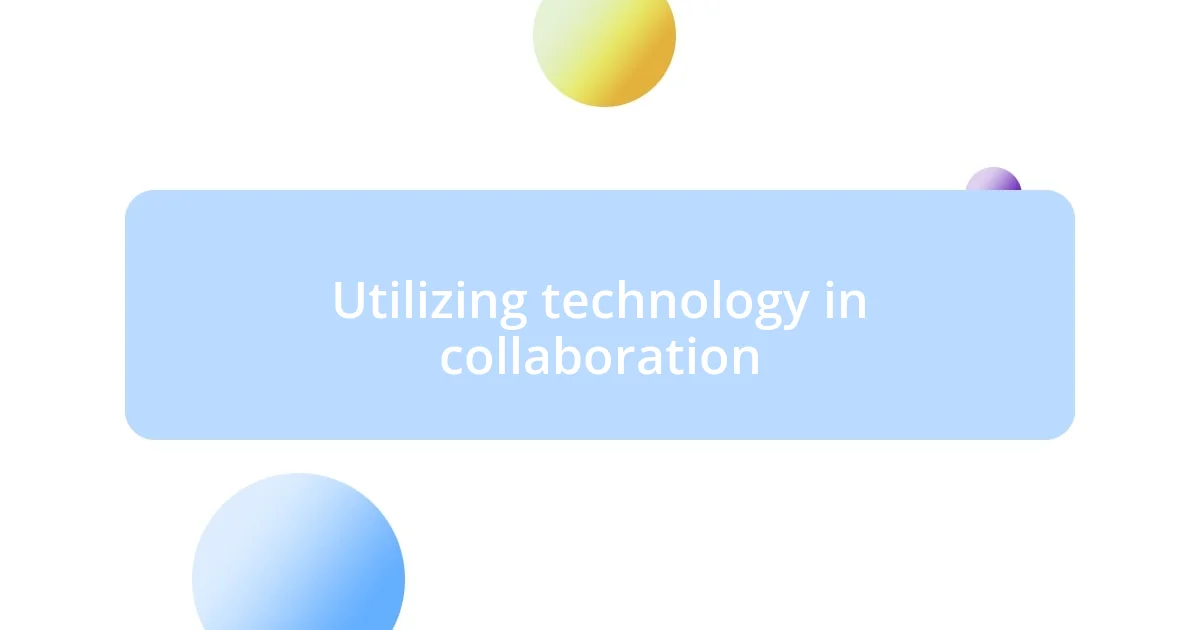Key takeaways:
- Teacher collaboration enhances professional growth, fosters community, and positively impacts student outcomes through shared strategies and cohesive curricula.
- Effective collaboration relies on clear communication, shared goals, and leveraging technology to streamline efforts and increase productivity.
- Building a collaborative culture involves regular social interactions, professional development opportunities, and celebrating successes, while continuous reflection and feedback enhance ongoing improvement.

Understanding teacher collaboration benefits
One of the most significant benefits of teacher collaboration is the opportunity for professional growth. I remember a time when a colleague and I shared our lesson plans and strategies. Not only did I learn new techniques, but it also sparked fresh enthusiasm in my teaching approach. Have you ever felt that jolt of inspiration after discussing ideas with someone? It’s incredible how collaboration can reinvigorate our passion for education.
Collaboration also fosters a sense of community among educators, which can be a powerful motivator. In my experience, being part of a collaborative team helped me feel less isolated in my challenges. It’s comforting to realize that others face similar hurdles. How often do we underestimate the strength of shared experiences? Those moments of vulnerability create bonds that enrich our professional journey.
Furthermore, teacher collaboration positively influences student outcomes. When teachers work together, they can devise more cohesive and engaging curricula. I’ve seen firsthand how our joint efforts to align lessons improved student engagement and understanding. Isn’t it amazing how a little teamwork can make a world of difference in our classrooms? The ripple effect of collaboration extends far beyond just us as educators; it truly enhances the learning experience for our students.

Strategies for effective collaboration
Collaboration requires clear communication. I’ve found that setting aside time for regular check-ins with colleagues is essential. For instance, during our weekly meetings, we openly discuss our goals and challenges. This practice not only keeps everyone on the same page but also builds trust, allowing us to share our successes and setbacks freely. Have you ever thought about how much easier things become when you know your teammates are in your corner?
Another effective strategy lies in developing shared goals. When my team and I identify common objectives, it fosters a sense of purpose that drives our collaboration. I recall a project where we aimed to enhance our science curriculum. By pooling our resources and efforts, we created a robust program that engaged students like never before. It’s amazing how focusing on a united vision can propel us forward.
Lastly, leveraging technology can enhance collaboration significantly. I often use tools like shared online documents and messaging apps to keep the lines of communication open throughout the week. In one instance, these tools allowed us to co-create a presentation that was ready well ahead of schedule. Isn’t it fascinating how digital platforms can bridge gaps and streamline our collaborative efforts?
| Strategy | Description |
|---|---|
| Clear Communication | Regular check-ins encourage open dialogue and build trust among colleagues. |
| Shared Goals | Collaborating towards common objectives fosters a united purpose that enhances teamwork. |
| Leverage Technology | Utilizing digital tools can streamline communication and make collaborative work more efficient. |

Building a collaborative culture
Creating a collaborative culture in education is like nurturing a garden – it requires attention, support, and time. I’ll never forget the day our school decided to host casual meet-and-greet sessions for teachers from different grades. It was inspiring to see how many started sharing resources and teaching philosophies in just a couple of hours. Encountering diverse perspectives enriched our understanding of student needs and brought a newfound energy to our daily practices. Doesn’t it just feel right to be part of a community that truly collaborates?
To foster this sense of collaboration, I believe several key practices should be embraced:
- Regular Social Interactions: By creating spaces where teachers can enjoy informal gatherings, we build personal connections that strengthen professional collaborations.
- Professional Development Opportunities: Investing in joint training sessions encourages educators to learn together and grow as a cohesive unit.
- Celebrate Success Together: When I experience team triumphs, whether big or small, celebrating together reinforces our shared purpose and strengthens the bonds between us.
These elements contribute to an environment where collaboration flourishes, making it the norm rather than the exception within our schools.

Utilizing technology in collaboration
When I think about utilizing technology in collaboration, the impact of real-time document editing tools instantly comes to mind. Just last semester, I teamed up with a few colleagues for a cross-curricular project, and we found that using a shared Google Doc allowed us to brainstorm and outline our ideas simultaneously. It was incredible to see everyone contributing in real time. Have you ever experienced that moment when all the pieces just seem to fall into place as a group?
Moreover, I adore video conferencing platforms like Zoom for connecting with peers who aren’t on my campus. One afternoon, we set up a virtual happy hour to discuss our teaching strategies, and the creativity that flowed was exceptional. It felt like we were right there in the same room, sharing laughs and insights. Isn’t it amazing how technology can dissolve geographical barriers and bring us closer together, even when we’re miles apart?
Finally, project management software has completely transformed how I approach collaborative efforts. By organizing tasks and deadlines in tools like Trello, I’ve seen my team’s productivity soar. A memorable instance was when we planned a school event; breaking everything down into manageable tasks allowed us to support each other effectively. It struck me how often clear organization can prevent overlap and confusion—haven’t you noticed that a well-structured plan can uplift even the most daunting of projects into something achievable?

Overcoming collaboration challenges
I’ve seen firsthand that collaboration can sometimes encounter bumps in the road. For instance, during a team project where we aimed to revamp our curriculum, some teachers hesitated to share their ideas due to past criticism. To address this, we introduced a rotating feedback session, where we emphasized constructive praise. What a difference it made! Everyone began to open up, fostering an atmosphere of trust and support.
Another challenge I’ve encountered is scheduling conflicts, which can turn collaboration plans into a frustrating puzzle. When my team and I struggled to find common meeting times, I suggested we use a shared calendar tool. This simple step not only made scheduling easier but also encouraged transparency in our commitments. Have you ever noticed how a little organization can truly transform a chaotic situation into a seamless collaboration?
One of my most rewarding experiences was overcoming a communication barrier when collaborating with a new teacher. Initially, we used email to discuss project details, but it felt cumbersome and left room for misunderstandings. So, we switched to quick daily check-ins over coffee, and it was incredible how this informal setting got us on the same page. Isn’t it remarkable how changing our communication style can dramatically enhance our collaborative efforts?

Measuring collaboration success
When it comes to measuring the success of collaboration, I always look at the impact on student outcomes first. Recently, I was part of a project where we integrated various teaching methods, and I noticed a tangible increase in student engagement and performance. Isn’t it rewarding to see those numbers reflect the hard work we put in together?
Another key factor I consider is the level of participation and enthusiasm among team members. During a collaborative workshop, I observed that our group’s energy and willingness to contribute significantly improved over time. Reflecting on it, I realized how vital it is to create an environment where everyone feels valued; it truly shapes the overall experience.
Lastly, I’ve found that collecting feedback after a collaborative project is essential for future improvements. After completing a recent curriculum design project, we held a debriefing session to discuss what went well and where we could improve. It was enlightening to hear diverse perspectives and makes me wonder—how often do we take the time to reflect and iterate on our collaborative practices? This practice not only elevates our future collaborations but also strengthens relationships among team members.

Best practices for ongoing improvement
I believe one of the best practices for ongoing improvement is regularly scheduled reflections on our collaborative efforts. For instance, in one of my teams, we set aside 20 minutes at the end of each month to share our successes and challenges. It was surprising to me how beneficial this time became! Suddenly, lessons learned and fresh ideas flowed more freely, making everyone feel included and motivated to push forward. Have you ever participated in a reflection session that transformed your perspective?
Another effective strategy I’ve noticed is to set clear, shared goals at the beginning of a collaboration. During a literacy initiative I was part of, we spent a good hour hashing out our collective objectives. This alignment kept us focused and, more importantly, ensured everyone was on the same page. How often do we really take the time to clarify our aims from the get-go?
Finally, I advocate for creating a culture of mentorship within collaborative teams. I had the privilege of pairing with a new teacher who brought fresh approaches to our discussions. By fostering this mentorship, we not only improved individual skills but also strengthened team dynamics. Isn’t it fascinating how one connection can ripple out and enhance our overall collaborative practice?














